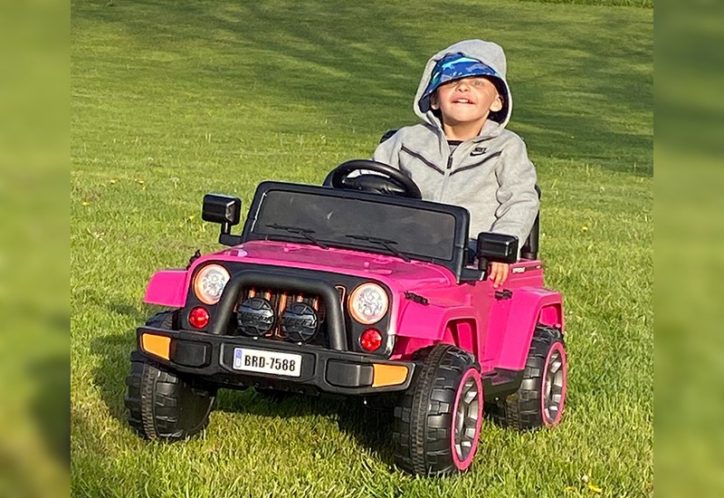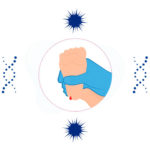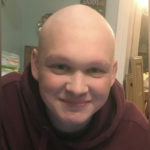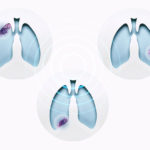Pleuropulmonary blastoma: Caring for Cal

Each time the UPS truck makes its way up Becky Baker’s driveway in Lyons, New York, her 3-year-old grandson, Cal, is certain there’s a package for him. Today, the delivery is in fact for Cal — but not exactly the drivable mini Jeep he was hoping for. “Those are your diapers, buddy,” his grandmother says, smiling lovingly. She watches as Cal hugs the UPS driver and awkwardly attempts to maneuver the large box.
“He’s my world, grandma’s best friend,” she says.
The two are especially close — Cal lives with his mom and grandmother — and have become even more so since last year when their world became a snow globe turned upside down. One moment, Cal was healthy, the next winded and wheezing. Then Thanksgiving Day, the incomprehensible.

Pleuropulmonary blastoma
Doctors at a nearby hospital discovered a baseball-size tumor at the top of Cal’s left lung. That tumor had a name, one Becky has never heard of — pleuropulmonary blastoma (PPB), a rare childhood lung cancer that forms in the tissue of the lung and the covering of the lung, known as “pleura.”
Ordinarily, PPB is linked to a change (mutation) in the DICER1 gene. Having this mutation puts children at risk for many different tumors throughout the body, PPB being one of the most common and the most difficult to treat. One option is intensive surgery. The operation involves the removal of essentially everything in the chest cavity — the lung; the pleura; the diaphragm, which is attached to the pleura; and the pericardium, the covering of the heart. Then, surgeons reconstruct the diaphragm using a piece of GoreTex, the same material used to make jackets but a biological grade.
Since childhood cancer is rare and PPB is one of the rarest forms, very few hospitals offer surgery for this type of tumor. However, it is a procedure Dr. Christopher Weldon, a surgical oncologist at Dana-Farber/Boston Children’s Cancer and Blood Disorders Center, has performed dozens of times.
“Our expertise with PPB really lies in the surgery,” says Dr. Weldon. “It’s not like our chemotherapy is better. It’s not like we have a silver bullet. It’s simply a surgery we’ve had success with, and long-term survival.”
For Becky, “it was a no-brainer.” The “strong little fighter,” as she calls Cal, would undergo surgery in February with Dr. Weldon.
Because Cal’s tumor shrank during chemotherapy after his initial diagnosis, Dr. Weldon says, he was the perfect candidate for this type of aggressive operation. “Cal’s response to chemotherapy was so great we were able to marry it with the best local control option — surgery — and remove the entire tumor with negative margins (no cancer cells at the outer edge of the tissue removed) and with no evidence of tumor left behind.”

Back home and holding onto hope
A week after surgery, Cal was home in New York. “He has recovered very well,” says Becky. “I don’t think he understands what’s going on. He definitely doesn’t like the fact he doesn’t have hair, but it’s coming back.”
Since the operation, he’s undergone multiple rounds of chemotherapy — a continuation of his treatment. Now, he’ll be monitored regularly for any signs of the cancer. “I wish I could take all of his pain away,” says Becky.
Time is precious in the Baker home.
Joy arrives in big and small packages — cruising in a hot-pink jeep (thank you, UPS), playing in the yard, splashing in the water, taking time to appreciate something as simple as the rain. And hugs: “Lots of them,” says Becky.
Recently, Cal started preschool. On his first day, when his grandmother dropped him off, he begged her to come with him. “I can’t, buddy,” she says. “But here’s a hug for your pocket.” Cal smiled and tucked the hug into his shorts’ pocket for safe keeping.
Another memory, another special moment Becky will tuck away too.

Learn more about the Dana-Farber/Boston Children’s Childhood Rare Tumors Program.
Related Posts :
-

Too many blood cells: Probing a blood cancer’s genetic origins
At age 7, Meredith Shah began having debilitating migraine headaches. “I would have trouble seeing and shapes were blurry,” she recalls. “...
-

Newborn genetic screening for pediatric cancer risk could save lives
Numerous genetic mutations increase children’s risk for various cancers. When they are detected early, cancers can potentially be caught ...
-

A surprising diagnosis leads to treatment for Liam’s liver cancer
For Liam Dickerson, what started as a simple sick day turned into a journey he never could have expected. In 2018, ...
-

Lung 'organoids' capture early-stage lung cancer; could help test treatments
Lung cancer, the leading cancer killer in the U.S., is often missed in its earlier stages. And while recent ...





